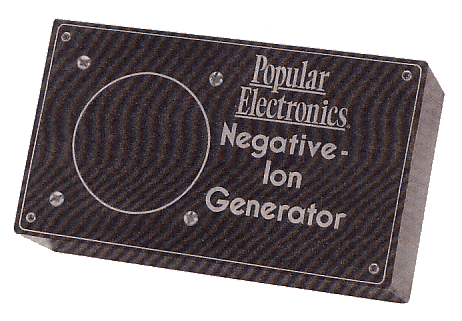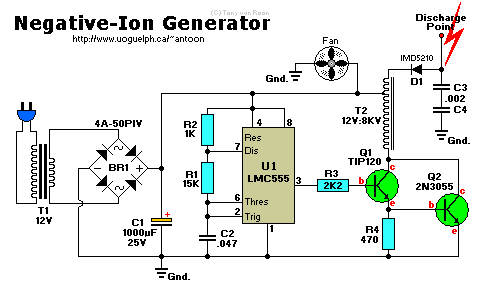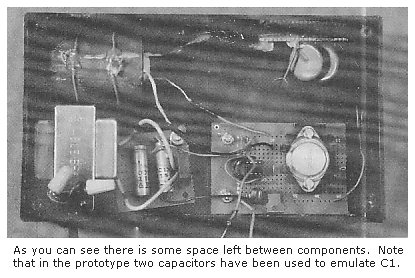
Negative Ion Generator
by John Iovine
Make the very air you breathe healthier with an easy-to-build high voltage project"
Air is the most important ingredient to our survival. Think about it; you
may survive a few days without water, a little longer without food, but, deprived of air, your survival time can be
measured in minutes.
The quality of the air surrounding many cities has become so poor that many local news stations provided an air-quality
report along with the weather forecast. Air pollution is so commonplace now that words have been created to describe
it. The word "smog" for example, a contraction of the words "smoke" and "fog". As if smog wasn't enough, today there
are new pollution concerns, not the least of which are the increasing CO2 level, the green-house effect, the depletion
of the ozone layer, and acid rain.
Research:
Long before there was any talk or concern about air pollution and such, some scientists and experimenters noticed that
the ionization of even clean air can improve its quality. Clean air (principally composed of 78% nitrogen and 21%
oxygen) is typically full of positive and negative ions in approximately a 5-to-4 ratio. What researchers found was
that when this ratio changes one way or the other it has an effect on biological systems.
This idea was popularized by Fred Soyka who, in the 1970's, wrote a book titled "The Ion Effect". Mr Soyka studied
natural occurrences of negative and positive ionized air. His findings and inquiries demonstrated that negatively
ionized air had substantial health benefits.
 To summarize a few points from his book, negative ions help elevate mood, enhance physical performance and training,
and sterilize harmful airborne bacteria. An abundance of positive ions on the other hand can be held responsible for
a number of low grade medical problems, such as fatigue, headache, and anxiety.
To summarize a few points from his book, negative ions help elevate mood, enhance physical performance and training,
and sterilize harmful airborne bacteria. An abundance of positive ions on the other hand can be held responsible for
a number of low grade medical problems, such as fatigue, headache, and anxiety.
There are detractors to this point of view. So before I started to design a negative-ion generator, I did some
research to find out if it would be worthwhile. I surveyed approximately 100 world-wide scientific reports on the
effect of negative ions from 1973 through the present (1992). I can report that out of my survey approximately 80%
of the citing's note the beneficial effect of negative ions. Greater than 19% of the reports described no effect, an
a few (less than 1%) detailed some detrimental effect. Since the preponderance of the evidence supports the beneficial
effect of negative ions, I felt that building and ion generator was a worthwhile project. A summary of some of the
beneficial effects reported by some researches are listed in the boxed text entitled "The Positive Effects of Negative
Ions". It is by no means and exhaustive list, it's just a sampling of the scientific benefits noted. But if this is
the case it would be to our benefit to improve the quality of air that we breathe with a negative ion generator.
Despite the numerous scientific reports supporting the health benefits of ionized air, no manufacturer of negative-ion
generators can make any health-benefit claims without running afoul of the FDA. For that reason I also will make no
such claims. Instead, the research papers supporting this article are listed in the text entitled "Bibliography" so
you can do the research on your own an make your own decision.
 The Ion Generator:
The Ion Generator:
The design of the Negative-Ion Generator is fairly straightforward (see Fig. 1). The circuit is a high voltage
generator. It contains a standard 555 timer that's used to generate square-wave pulses. The pulses are applied to
the base of the TIP120 NPN Darlington transistor. The Darlington provides sufficient current to the base of the 2N3055
power transistor to turn it on. Each time that happens, current flows through the high voltage auto-transformer, T2.
The high voltage lead of the transformer is connected to a 10 kilovolt high voltage diode. Notice the polarity of the
diode. It is biased to place a negative charge on C3 and C4, leaving the discharge point negatively charged. The
voltage at the discharge point negatively charges the air forced past it by the fan.
The author's prototype was built on sections of perfboard using point-to-point wiring. It is a suitable method that
you can use in your won ion generator provided you follow some precautions: Make sure you place C3, C4, D1, and the
discharge point (which we'll describe momentarily) on a piece of perf board all their own. The junctions between
those components should be at least a centimeter (about 1/2-inch) apart. Both this little high voltage board and the
autotransformer should also be kept at least 1 centimeter away from the perfboard containing the other components, the
fan, and the power transformer.
In passing, if you chose not to buy D1 from the supplier (1992) mentioned in the Parts List, an exact replacement may
be difficult to locate. However, even though it has a lower current rating, an ECG518 or NTE518 should work fine,
although this substitution has not been tried.
The discharge point should be "pointy" to enhance the ionization of the air. You can use a sewing needle, for example.
An alternate discharge point can be fashioned from a small piece of No. 22 stranded wire. Strip off about 1/2-inch
from one end of the wire and separate the fine copper strands so that they are more of less evenly dispersed. When the
wire is connected to the high negative voltage, the end of each strand will behave as a discharge point.
Any screen or covering on the fan-outlet hole should be non-metallic or plastic in nature. Using a metal screen would
severely cut the efficiency of the generator because the negative ions that come into contact with the metal screen
would be neutralized.
When testing the circuit, if you see any arcing or discharge from the high voltage transformer or high voltage
capacitors, cut the power immediately. Let the project sit for awhile to let the capacitors discharge, and, without
touching the project if possible, coat the faulty are with a little "No Arc" spray (available from Radio Shack or
Tandy). Allow the material to dry before testing the unit again.
(Tony's comment: The ECG518 and NTE518 are still available, the added bonus is that the ECG/NTE518 supplies 25mA
instead of 10mA by the IMD5210).
Parts List:
R1 = 15K, 1/4W, 5%
R2 = 1K, 1/4W, 5%
R3 = 2.2K, 1/4 W, 5%
R4 = 470, 1/4 W, 5%
C1 = 1000uF/25V, electrolytic
C2 = 0.047uF, polyester-film
C3,C4 = 0.002uF, 6000WVDC, ceramic disc
U1 = 555 timer, 8-pin IC (no CMOS)
Q1 = TIP120 or NTE261, NPN, Darlington transistor
Q2 = 2N3055, NPN, power transistor
D1 = 10,000 Volt, 10mA, SI rectifier diode (see text)
BR1 = 4A, 50-PIV bridge rectifier
Additional Parts and Materials:
T1 = 12 volt 1.2A, power transformer
T2 = 12 volt to 8 kilo volt autotransformer
FAN1 = 12 volt DC fan.
Enclosure, line cord, switch, TO-3 socket/heat sink, perfboard, wire, solder,
hardware, etc.
The original supplier was "Images Company" , P.O. box 14072 Staten Island,
NY 10314-024; Tel. 718/698-8305): D1 ($1.50), C3 and C4 ($1.50 each), and T2
(17.95). Include an additional $2.50 for shipping and handling.
(Tony's note for the above: This is the original information as it appeared in Popular
Electronics at the time in 1992. The company may no longer exist or if it does,
may no longer have the components, or charge different prices, etc, etc.)
 The Positive Effects of Negative Ions:
The Positive Effects of Negative Ions:
- Learning enhancement in normal and learning-disabled children. The task
used to test the children was a dichotic listening test.
- Negative ions can be used to decrease amounts of radon in a building atmosphere.
- In one animal study, 1279 calves were broken into two groups, one of 649
head and the other of 630 head, negative air ionization was used to test for a
prophylactic effectiveness against respiratory diseases. The results were
remarkable: In the treated group (649 head) 45 calves became sick and 3 died.
In the control group (630 head) 621 became sick and 33 died.
- A 40-50% reduction of microbial air pollution in dental clinics.
- A test using college students showed improved performance on a visual
vigilance task.
- In 1983 it was reported that chickens raised in a negatively ionized atmosphere
showed improved anabolic processes. The chickens raised in negatively ionized
air had an overall greater weight than a control group fed the same quality and
quantity of feed. The meat of the treated group had higher protein and essential
amino-acid content. In addition, higher concentration of vitamins E and A were
found in their livers.
Bibliography:
"Negative Air Ion Effects on Learning Disabled and Normal Achieving Children", L.L. Morton and J.R. Kershner,
University of Windsor, Faculty of Education, Ontario, Canada, 1990.
"Effect of Negative Ion Generators in a Sick Building", M.J. Finnegan, C.A. Pickering, F.S. Gill 1st, Aston,
and D. Froese, Department of Thoracic Medicine, Wythenshawe Hospital, Manchester, England, 1987.
"Aeroionization in Prophylaxis & Treatment of Respiratory Disease in Calves", T.I. Sologub, N.F. Borzenko,
V.P. Zernlyanskiy, and K.F. Plakhotnyy, Russia, 1984.
"Effect of Ionization on Microbial Air Pollution in the Dental Clinic", J. Gabby, O. Bergerson, N. Levi,
S. Brenner, and I. Eli, Research Institute for Environment Health, Sackler School of Medicine, Tel Aviv, Israel, 1990.
"Effects of Ionized Air on the PErformance of a Vigilance Task", G.C. Brown and R.E. Kirk, Systems Research
Laboratories, Inc., Brooks Air Force Base, Texas, USA, 1987.
"Negative Ions", J.E. Wright, Muscle & Fitness Magazine, January 1991.
"Effect of Artificial Air Ionization on Broilers", P. Stoianov, G. Petkov, and B.D. Baikov, Vet Med Nauki,
Bulgaria, 1983.
Copyright and Credits
This article is copyright by the author, John Iovine, and first published in the 1992 issue of "Popular Electronics
Magazine", and published by Gernsback Publishing (no longer in business).
Back to High Voltage Projects Index
Copyright © 2005 - Tony van Roon


 To summarize a few points from his book, negative ions help elevate mood, enhance physical performance and training,
and sterilize harmful airborne bacteria. An abundance of positive ions on the other hand can be held responsible for
a number of low grade medical problems, such as fatigue, headache, and anxiety.
To summarize a few points from his book, negative ions help elevate mood, enhance physical performance and training,
and sterilize harmful airborne bacteria. An abundance of positive ions on the other hand can be held responsible for
a number of low grade medical problems, such as fatigue, headache, and anxiety.
